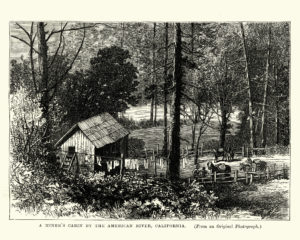
On the cold, snowy morning of April 16, 1849, 120 citizens of Fayetteville, Arkansas, gathered in the town’s central square to bid farewell to family and friends who set out on the difficult, dangerous, overland trek across the wild Midwest and the Rocky Mountains to California—in search of gold.
Edward Freyschlag and several of his siblings joined this group, as did the young adventurer, William James Hawkins (1832-1856), son of Martin Luther Hawkins and Jane Curl Walker.
After arriving in California, many prospectors had modest success panning for gold in the Sierra Mountain creeks. At least enough to support themselves for a while. At some point, the mountains of California became prospected out, and most “49ers” (the gold prospectors’ nickname) returned home. Edward and his wife Lucy Hawkins Freyschlag exchanged several letters while Edward was in California: these can be found in the Jane Curle Walker Letters.
Edward Freyschlag’s Return from California
Edward evidently did well enough prospecting that he was able to take the safest, most comfortable route back to Arkansas when he was ready to return in 1851 — by ship on the Pacific Ocean from San Francisco, all the way south around Cape Horn, and back up to New Orleans. From there, he traveled up the Mississippi and the White Rivers to Fayetteville. The water route was a long journey, but it was the preferable way to return from California.
There were two other options for travel between California and Arkansas, both less expensive and more dangerous than this Cape Horn voyage. A modestly expensive option was to travel by ship to Nicaragua, then to cross the Central American isthmus on land, and finally travel by ship to New Orleans. The land route across the isthmus was somewhat dangerous because of malaria and thieves.
The least expensive route from California was to return by land across the Rocky Mountains and central plains, but unless one could travel with a large, armed group, this crossing was treacherous because of the constant threat of hostile Indians and thieves.
Not all of the “49ers” left California. Edward’s brother Christian Freyschlag did quite well in the gold rush, but not as a prospector. He took supplies by mule train to the Sierra foothills and sold shovels, pick-axes, and the like to gold hunters. At least one of Christian’s sisters ran a boarding house for miners. Christian and several of his sisters remained in California for the rest of their lives.
William James Hawkins
Lucy Hawkins’s young brother William James Hawkins traveled to California with the Fayetteville group that left on April 16, 1849. wrote several letters to his mother, Jane Curl Walker Hawkins, and wrote of his dream of finding enough gold to help his mother improve her circumstances. He also hoped to become wealthy enough to woo Sallie Wilson—his heartthrob back in Fayetteville.
James found the indigenous tribes in California especially friendly and wrote of having spent a lot of time socializing and dancing with them.
We don’t know if James returned to Fayetteville before embarking on his next fateful adventure as a filibustero (or mercenary soldier) in Mexico in 1855, an adventure that would take his life.
“Filibustero” is a Spanish word for pirate. In the 1850s, thousands of Americans traveled to Mexico and Central America to participate in various small military actions as mercenary soldiers. The adventurers’ motivations were many and varied. There was a movement in the South, supported by President James Buchanan, that encouraged seizure of Central American land, even entire countries, in the hopes of extending the slave economy south of the border and building a vast agricultural empire from the southern U.S. through Central America in order to monopolize cotton and sugar trade worldwide. However, the motives for young men like James Hawkins were likely more prosaic: money, adventure, and the companionship of exotic women.
In the summer of 1855, James Hawkins enlisted with a group of 85 filibusteros who were to sail from San Francisco on the ship Archibald Gracia to join an infamous adventurer, William Walker, who had gone earlier to Nicaragua and had declared himself President of that country. [This William Walker was probably not a relative of Jane Walker’s.]
At the last minute, before the filibusteros sailed from San Francisco, they were convinced to change their destination by the Italian adventurer Juan Napoleon Zerman, who planned to intercede on behalf of General Juan Alvarez in Mexico, who was fighting Santa Anna. The Archibald Gracia set sail on October 11, 1855, to sail to La Paz in Baja, Mexico.
When the ship arrived, it was captured, and all the men were taken prisoner. They were eventually marched to Mexico City under harsh conditions. Finally, in the early summer of 1856, the prisoners were taken to the Gulf port of Vera Cruz for repatriation to the United States. James Hawkins was put on a boat bound for New Orleans.
When James arrived in New Orleans, he was mortally ill with yellow fever. He was admitted to Charity Hospital in New Orleans on July 27 and died four days later, at the age of 24.
© 2013 W. Mullins
